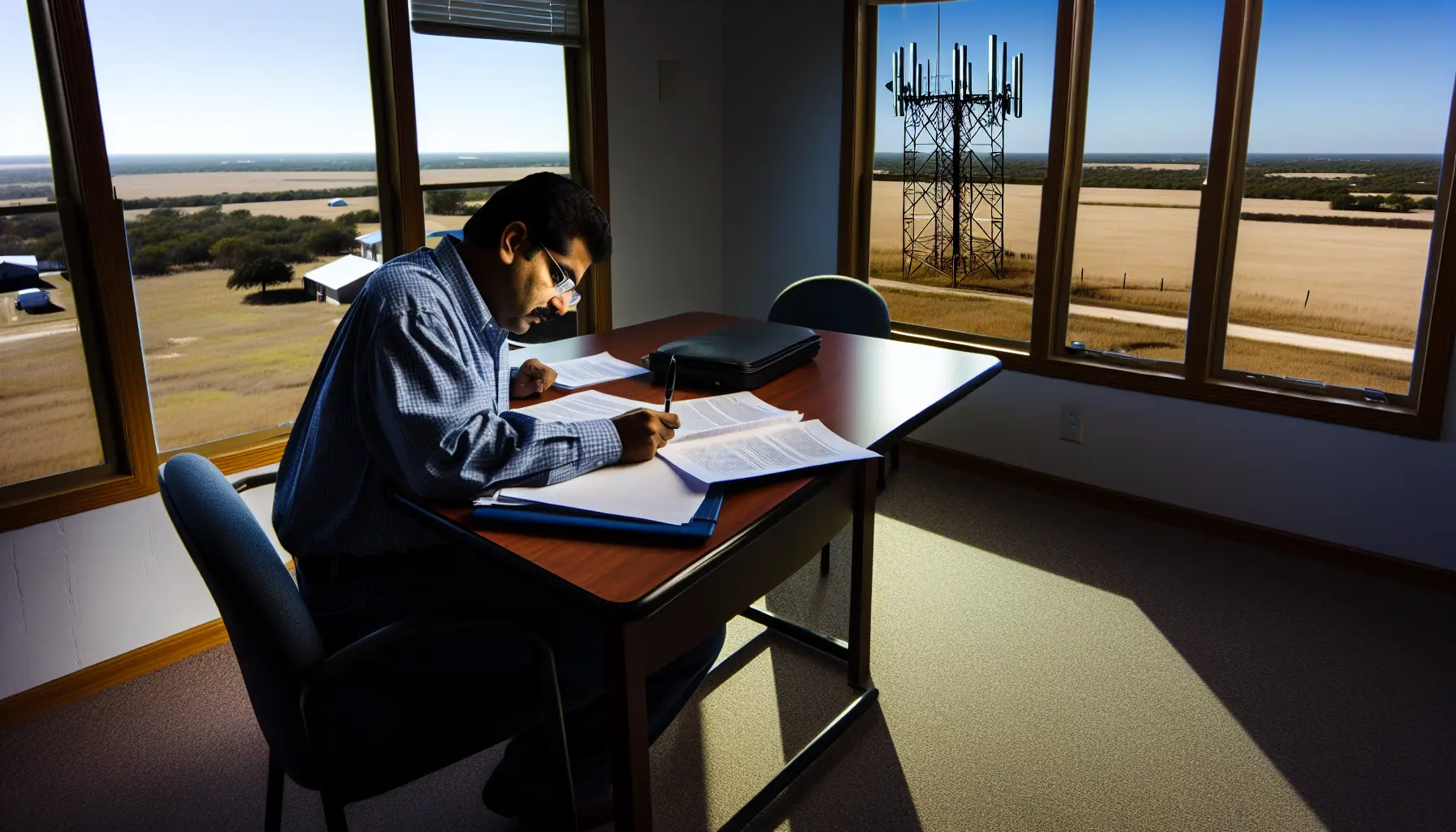Many landowners in Texas are now hearing more about cell tower leases. These cell tower lease offer a way to earn income using land they already own. If a company wants to place a cell tower on your property, they often offer to pay rent through a lease. This lease can last for many years, sometimes up to 20 or more. For those who want steady income without selling property, this may be a good option.
In This Article:
- How a Cell Tower Lease Works in Texas
- Different Types of Rent Structures
- What Makes a Lease More Valuable?
- Key Terms to Look For During Negotiation
- Understanding the Legal Side Without the Overwhelm
- Planning for Long-Term Growth and Exit Strategies
- Other Land and Law Factors to Know
- Simple Tips to Keep Your Lease Current
How a Cell Tower Lease Works in Texas
Understanding the Basic Agreement
A cell tower lease is a legal agreement. A tower company pays you to place equipment on your land. They may build a new tower or use space on an existing one. The lease gives them access to a certain section of your land. This deal does not give them ownership, just space for their business. As the landowner, you collect cell tower rent from the company.
The agreement usually lasts for many years. It covers lease terms, rent amount, access rules, and possible renewals. Each lease may be a bit different. It is important to know what each part means. Clear leases can limit conflict and ensure steady income.
Who Are the Main Parties Involved?
In most cell tower leases, three groups play a role. First is the landowner. You offer the land space and get paid rent in return. Second is the tower company. They build and maintain the tower. Third is the wireless provider, also known as the end user. This could be companies like AT&T or Verizon who supply calls and internet to phone users.
Each of these groups has different goals. The landowner wants fair rent. The tower company wants space. The wireless provider wants fast, stable coverage. When all parties benefit, the lease works well for everyone. Making sure your voice is heard is key to a successful deal.
Different Types of Rent Structures
Fixed Rent Agreements
Fixed rent is the simplest structure. The tower company pays a set amount each month or year. You know exactly how much income to expect. Planning your budget is easy with this steady stream of rent. Fixed rent remains unchanged over the lease period unless the lease includes a raise clause.
But there are downsides. If tower use increases, your income stays the same. As market rates grow, your deal may fall behind. With a fixed agreement, your profit may not reflect real land value. This is why reviewing terms often makes sense.
When Percentage Rent May Pay More
With percentage rent, your income depends on tower use. If more carriers join or demand grows, your rent increases. This means your lease is tied directly to how valuable the tower space becomes. You share in the growth of technology demand.
This deal rewards long-term demand increases. But it has risks too. If fewer users or carriers use the tower, your rent falls. Some landowners feel unsure with changing income. Balancing these pros and cons is important before signing.
Blended Rent – A Mix of Fixed and Percentage
Many landowners find blended rent most useful. This type pays a stable fixed rent plus extra money from tower use. You earn basic income each month. In good years, you also get a bonus from stronger tower use.
This structure offers more safety. It reduces risk while still offering chances for growth. More land lease agreements now follow this model. It helps you benefit from rising demand without losing regular income.
What Makes a Lease More Valuable?
Strong Location and Market Demand
Not all land is equal in cell tower leasing. Location is key. Rural land with limited coverage is more valuable. Companies want to expand their network into places with poor service. If your land fills a coverage gap, it becomes important fast.
Growing towns or suburbs also have demand. As population increases, towers must expand service. Studying cell tower lease Texas landowners’ deals can offer a lens into market growth. When landowners know what makes a lease strong, they can ask for better terms. Understanding your location’s value is your first step toward income growth.
The Power of Tower Sharing
Tower sharing allows many carriers to use the same tower. This makes your land far more valuable. Each added carrier can mean extra rent. In areas with demand from several wireless companies, one tower may serve all.
If a carrier joins later, the tower company earns more. With the right lease, so will you. This detail is sometimes missing in early deals. Asking about this option early is important. Real estate law can help clarify how your lease should reflect shared use.
Key Terms to Look For During Negotiation
Why Escalation Clauses Matter
An escalation clause raises your rent over time. It could be tied to inflation or set as a yearly increase. This protects your income from rising prices. Many leases last 20 years or more. Costs will go up during that time.
Without a rent increase, your income loses value. Including an escalation clause now keeps your rent strong later. Most cell tower companies expect this, so it pays to ask. These small steps can make a big difference over time.
How to Avoid Underpaid Rent
Sometimes, leases do not reflect the true value of the land. This happens when tower companies offer standard terms. They may not share what others in your area are paid. Checking average rent rates helps avoid this problem.
Ask about extra carriers or upgrades to the tower. These changes may raise the value of the lease. But if your deal does not reflect those upgrades, you might miss extra payments. Real estate investors often check lease rates before signing. This good habit guards against growing rent gaps.
Understanding the Legal Side Without the Overwhelm
Complex Lease Terms Simplified
Cell tower leases often include hard-to-read terms. These terms may block your access to parts of your land. They may also last longer than you expect. Some leases renew on their own and limit future use of the space.
It helps to break the lease into simple pieces. Consider what actions the company can take without asking you. Ask how changes to land use will be handled. These small points add up. Understanding your rights ensures you stay in control of your property.
Risks in Standard Lease Documents
Many companies start with a standard lease. This is a form they use for every landowner. But standard forms usually favor the company. They may reduce your rent options, allow long-term land use, or skip payment reviews for upgrades.
Looking at these terms early gives you more control. You can ask for changes that suit your needs. Real estate lawyer for lease negotiation options can help if the terms seem one-sided. That way, your lease fits your goals, not just theirs.
Planning for Long-Term Growth and Exit Strategies
How the Lease Changes Over Time
Leases usually include several stages. First is the primary term, when the tower goes up. Then come possible renewal periods. Some leases also allow early cancelation with notice. Others offer buyouts during the term or after a few years.
Knowing these stages helps you plan. You can prepare for rent changes. You can also make better use of the land during off periods. Staying aware of lease timing protects your income from future surprises. Oil and gas lease attorney Texas professionals may also offer insights if your land holds mineral rights.
Should You Accept a Lease Buyout Offer?
Sometimes a buyer offers to pay one large sum to end your lease. This is called a lease buyout. You get money all at once, not each year. Some owners like the quick cash. Others prefer the steady income over time.
To decide, compare your annual rent to the lump sum offer. Think about how long the lease still has to run. Use simple math to see which pays more. It also helps to factor in taxes. Lease buyouts are often lower than the lease’s full value, so act with care.
Other Land and Law Factors to Know
Can You Lease Land With Existing Mineral Rights?
Many Texas landowners also hold mineral rights. These give you income from oil or gas below the ground. Sometimes, surface rights needed for towers may conflict with underground activities. This adds rules to leasing decisions.
To protect all parts of your land, know how cell towers may affect mineral rights. Some leases block drilling near the tower. Others require surface cleanup. Real estate professionals familiar with mineral rights can help evaluate these terms.
Land Use Questions Near Cities Like Houston
Urban land values often differ from rural ones. Cities like Houston have strong cell demand. But land use rules may limit where towers can go. Local rules may require zoning changes or permits before a tower build can begin.
Houston real estate attorney help often becomes important in these cases. A lease in town may bring high rent, but the process to start takes longer. Being patient and informed can increase your long-term income. This is another reason why staying involved in the process pays off.
Simple Tips to Keep Your Lease Current
Always Review Your Lease Before Renewal
Even long-term leases need review. Market values change. Carriers join or leave towers. Upgrades may add value. Keeping quiet could lead to missed income. This is why periodic checkups make sense. Real estate law allows you to suggest changes when renewal time comes.
Take time before the renewal period to prepare. List what changed since the lease started. Talk with others who have similar leases. Understanding what is fair now helps you adjust rent later. Being proactive gives you more control.
Record Keeping and Ongoing Oversight
Once a lease is active, do not forget it. Keep good records. Track payments. Watch for missed bonus pay from added carriers. Verify access visits and space used. This process helps avoid missing money or changes you did not approve.
Sometimes landowners realize years later their lease does not reflect real site use. Staying organized helps fix problems early. You can also catch mistakes in rent payments over time. Small steps each year add up to better income management.
Conclusion
Leasing land for a cell tower is one way many Texas landowners earn extra income. But while the idea sounds simple, the details can be complex. With the right plan, a cell tower lease can add long-term value to your land. From fixed rent to blended models and tower sharing, your choices today shape your income tomorrow. Keeping your rights protected, knowing your land’s worth, and checking the market over time help you make stronger decisions.
If you need help understanding your lease or wish to explore terms further, the team at Daughtrey Law Firm has experience in real estate law and lease negotiation. Our approach is detailed, thoughtful, and focused on helping you protect your land and income for the long haul.












